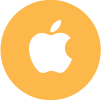Flutter Application Developement
Apps made using Flutter are known to perform better and work smooth and fast. The SDK’s inherent capabilities eliminate the chances of hanging while scrolling ensuring desired performance on mobile apps.
Flutter promises a constant response time which ensures the app does not stutters or hands while using. This is because Flutter promises 60fps display which is suitable for modern mobile screens to display a glitch-free interface.
Flutter offers Hot Reload option to the developer that allows them to make changes to the app code in real time. This means they can add features, fix bugs and experiment swiftly to speed up the development process.
As code reusability is one of the most important features of Flutter, developers can build apps for multiple platforms without having to write code from scratch. This promises faster development and reduces TTM.
Flutter can be used to create apps with a dynamic user interface that works well even on older versions of Android & iOS. This means consistent user experience without a glitch or any reason for users to get disappointed about.
Flutter has a lot of in-built design-centric features and widgets that can be used by app developers to create intuitive user interfaces, without much effort. What’s more, UIs on Flutter are dynamic owing to reactive programming and getupdated with the change in variables.
Flutter offers a host of design-centric widgets, development tools and APIs to facilitate the development of next-gen app with stunning UI and powerful capabilities, without investing a lot of time and effort.
As Flutter is a complete SDK, it has its own library and custom widgets that can be used as per the app’s requirement. Developers need not code from beginning and can make use of the ready-made widgets that offers modern capabilities to an app.
A minimum viable product (MVP) is needed by startup to quickly roll out a functioning version of their app to showcase to investors or for real-life testing. As Flutter supports swift development and makes it easier to make changes to the app in real time, it is suitable for MVP development.
As Flutter promises faster development and deployment, it becomes more suitable for startups looking for MVP development owing to low costs and reduced time-to-market.
Using Flutter, developers can easily access native features even on low-level machines. As Flutter is cross-platform SDK, code reusability ensures a streamlined native experience across platforms.
Flutter’s inherent capabilities to access OEM features and widgets without a Java bridge ensures that the native experience is much better than apps developed via other frameworks.
As Flutter supports code-reusability, it becomes cheaper for companies to roll out cross-platform mobile apps. With the same budget, startups and businesses can reach out to customers across multiple platforms.
As Flutter promises faster development and cross-platform interoperability using the same set of code, developing apps via Flutter is more cost-efficient when compared to other frameworks. Also, as it is a progressive technology, more and more developers are trying their hands on it, increasing the resource pool.
As Flutter is a complete SDK, it can be installed and run on any device and be used for migrating apps from other frameworks for further iteration and development.
Apps developed via other frameworks can be easily migrated to Flutter owing to its compatibility and interoperability features. Moreover, it facilitates seamless migration as it is a complete SDK with inbuilt tools and libraries.
Flutter has an ever-growing global developer community owing to its promise of offering entire SDK in a single package. This means a developer can start from scratch and quickly setup the development engine to kickstart the development process.
As Flutter is an all-inclusive package, it becomes easy for developers to configure their development engines. They are not required to depend on third-party libraries and installations which speeds up the setup process for app development.
Debugging Flutter code is extremely easy owing to Dart Analyzer and Observatory tools that helpin finding errors quickly using specific command syntaxes. Also, automated testing tools simplify the process of error discovery and rectification.
Its inherent automated testing tools makethe quality assurance process more refined which results in better-performing apps with minimum glitches or bugs after deployment.

 Team members
Team members We are hiring
We are hiring Our Services
Our Services Development Methodology
Development Methodology Infrastructure
Infrastructure Overview
Overview Mobile app development
Mobile app development IOS
IOS web development
web development UX/UI Design
UX/UI Design iPhone
iPhone Android
Android Web Site
Web Site Graphics Design
Graphics Design Hire iPhone Developer
Hire iPhone Developer Hire Android Developer
Hire Android Developer Hire Web Developer
Hire Web Developer Hire Joomla Developer
Hire Joomla Developer Hire BlackBerry Developer
Hire BlackBerry Developer Hire Titanium Developer
Hire Titanium Developer
